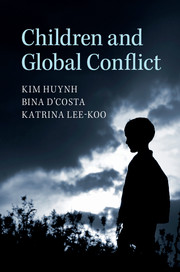Book contents
- Frontmatter
- Dedication
- Contents
- List of abbreviations
- Introduction: why children matter to global conflict
- 1 Children and armed conflict: mapping the terrain
- 2 Children and agency: caretakers, free-rangers and everyday life
- 3 Children and IR: creating spaces for children
- 4 The rights of the child: political history, practices and protection
- 5 Child soldiers: causes, solutions and cultures
- 6 Child forced migrants: bio-politics, autonomy and ambivalence
- 7 Children and peace building: propagating peace
- 8 Children and justice: past crimes, healing and the future
- 9 Who speaks for children? Advocacy, activism and resistance
- Conclusion
- Appendix
- Bibliography
- Index
Introduction: why children matter to global conflict
Published online by Cambridge University Press: 05 May 2015
- Frontmatter
- Dedication
- Contents
- List of abbreviations
- Introduction: why children matter to global conflict
- 1 Children and armed conflict: mapping the terrain
- 2 Children and agency: caretakers, free-rangers and everyday life
- 3 Children and IR: creating spaces for children
- 4 The rights of the child: political history, practices and protection
- 5 Child soldiers: causes, solutions and cultures
- 6 Child forced migrants: bio-politics, autonomy and ambivalence
- 7 Children and peace building: propagating peace
- 8 Children and justice: past crimes, healing and the future
- 9 Who speaks for children? Advocacy, activism and resistance
- Conclusion
- Appendix
- Bibliography
- Index
Summary
Just over 1 billion children under the age of eighteen live in countries or territories affected by armed conflict; that is, almost every second child, or one-sixth of the total world population. Of these, approximately 300 million are under the age of five. In 2012, an estimated 17.9 million children were among displaced and vulnerable populations, of which there were around 5 million refugee children and 9 million internally displaced children. In terms of sheer numbers and need, children clearly matter a great deal to global politics.
In recognition of this, the United Nations (UN) declared 2001–2010 to be the International Decade for a Culture of Peace and Non-Violence for the Children of the World. Given that the numbers of war-affected and displaced children remained largely constant over this period, it is worth looking back and asking some fundamental questions about what might be done to assist children in conflict zones. Are children any more or less deserving of peace than adults? Are they instinctively peaceful? Do they only become violent when raised improperly or within a conflict-ridden environment? Should campaigns for peace and non-violence incorporate children as a means of sustaining that mission across generations? How do we, as adults, scholars and policymakers meaningfully talk about and make representations for ‘the children of the world’?
These types of questions go to the core of Children and Global Conflict. Put succinctly, this book is concerned with the confluence of children, armed conflict, and the international responses to both. It illustrates how children can represent both the reason for waging war and the reason to move towards peace. The first half of the book focuses on the philosophical, theoretical and legal debates over how to conceptualise war-affected children. The second half applies these ideas to major issues relating to children and global conflict; namely, child soldiers, forced migration, peace building, justice and advocacy. The book considers the impact of these issues on children and how they in turn shape these issues in their own interests, according to their own principles, and for the sake of their own communities.
- Type
- Chapter
- Information
- Children and Global Conflict , pp. 1 - 8Publisher: Cambridge University PressPrint publication year: 2015

